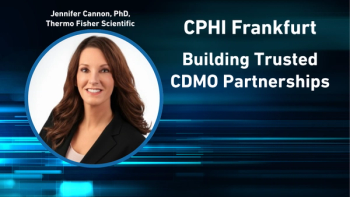
- Pharmaceutical Technology-10-02-2009
- Volume 33
- Issue 10
Sizing Up the CDMO Market
A new analysis highlights growth drivers and challenges for clinical supply-chain services.
During the mid-decade drug development boom, some of the biggest winners were those contract service providers that are part of the clinical supply chain. Contract development and manufacturing organizations (CDMOs) especially benefited from the dramatic increase in early-stage compounds, which fed a surge in demand for process development, formulation development, and small-scale manufacturing services.
Jim Miller
The subsequent downturn in development activity, prompted by the drop in the availability of capital, has hit CDMOs particularly hard. Double-digit declines have replaced double-digit increases, and many CDMOs are struggling to stay in business. No longer able to float on a rising tide of predevelopment candidates, CDMOs are fighting for market share and survival.
In an effort to better understand the dynamics of and outlook for the CDMO industry, PharmSource recently completed a major analysis of the clinical supply-chain market. We modeled the spend for clinical trial material (CTM) development and manufacturing, including process development and manufacturing for active pharmaceutical ingredients (APIs), formulation and manufacturing of dosage forms, and associated analytical activities (we excluded clinical packaging). We conducted extensive interviews with buyers and sellers of clinical supply-chain services to understand the key behaviors and trends driving the industry. The analysis goes into considerable depth on analytical chemistry activities.
Outsourcing highly penetrated
The PharmSource analysis estimates annual spend on CTM development and manufacture at about $9.3 billion, divided almost evenly among process and formulation development, analytical development and testing, and manufacture of CTMs. The biggest bucket of spending is in early development (preclinical and Phase 1), thanks to the large number of projects in the pipeline and the high cost of API characterization and process development, especially for large-molecule compounds.
The most revealing aspect of the PharmSource analysis is the degree to which contract services have already penetrated the clinical supply chain. We estimate that as much as two-thirds of CTM development and manufacturing expenditures are already outsourced, a much larger proportion than we expected. The principal source for contract services' large share is the small and mid-size biotechnology and pharmaceutical companies, which account for 88% of the outsourced spend. Small and mid-size companies tend to be highly dependent on contract services and account for 75% of the candidates in the new drug development pipeline. By contrast, large global companies, which account for one quarter of total development spending, make up just 12% of outsourced spend.
Mixed outlook
The PharmSource model highlights the dilemma faced by CDMOs: they benefited greatly as the number of early development candidates grew to more than 6000, a 55% increase from 1999, and are now suffering as the number of compounds slips back. Faced with a shortage of capital, early-stage companies have been forced to halt work on many candidates and expend funds on remaining candidates more cautiously. Our model projects that a 20% drop in the number of early-development candidates would result in a 10–15% drop in outsourced development spending, which is in line with what we are seeing now throughout the marketplace.
There is good news, however. The PharmSource model also points to some substantial upside opportunities for the CDMO industry. Most importantly, the continuing shift from small-molecule compounds to large molecules will likely be a significant boon to the contract services. We expect that if large molecules grow to 30% of the pipeline from their current 22%, total outsourced development spend will grow by 15%. Of course, where that spending takes place will shift as well. CDMOs specializing in large-molecule API characterization, process development, and manufacture will increase their market share while small-molecule API manufacturers will lose share.
The CDMO market is going through a significant restructuring as it adjusts to changing realities in the world of finance and the bio/pharmaceutical industry. There will be significant opportunities for contract service providers as we come out of the restructuring process, but there will definitely be winners and losers.
Jim Miller is president of PharmSource Information Services, Inc., and publisher of Bio/Pharmaceutical Outsourcing Report, tel. 703.383.4903, fax 703.383.4905,
Articles in this issue
about 16 years ago
Pharmaceutical Technology, October 2009 Issue (PDF)about 16 years ago
Looking Ahead: The Pharmaceutical-Science Industryabout 16 years ago
Statistical Solutions: Square Root of (N) + 1 Sampling Planabout 16 years ago
Formulation and Evaluation of Famotidine Floating Matrix Tabletsabout 16 years ago
Report From: Indiaabout 16 years ago
The Emerging Markets of the Eastabout 16 years ago
New Leadership Seeks to Transform FDAabout 16 years ago
Quality by Design for Generic Drugsabout 16 years ago
Getting the Truth out of Dissolution Testingabout 16 years ago
Technical Note: The Case for Supplier QualificationNewsletter
Get the essential updates shaping the future of pharma manufacturing and compliance—subscribe today to Pharmaceutical Technology and never miss a breakthrough.




